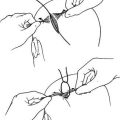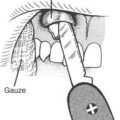DIABETES
Diabetes mellitus is a disorder in which the pancreas cannot create sufficient insulin (type 1 or insulin-dependent diabetes) or in which insulin is not effective (type 2 or non–insulin-dependent diabetes). Insulin allows the body to use and store sugar; in the diabetic state, the victim suffers from high blood sugar and an array of physiological derangements (kidney failure, skin ulcers, bleeding into the vitreous of the eye) associated with deterioration of small blood vessels. Many diabetics need to take insulin by injection or inhalation to manage the disease; others can control their blood sugar by diet, oral medications (hypoglycemic agents), or both. Oral medications include drugs that stimulate pancreatic cells to produce more insulin (e.g., glipizide [Glucotrol]), reduce sugar production in the liver (e.g., metformin [Glucophage]), reduce carbohydrate absorption and sugar “peaks” after eating (e.g., acarbose [Precose]), or reduce insulin resistance in the body (e.g., pioglitazone). Exenatide (Byetta) injection is used as a supplemental drug for certain patients with type 2 diabetes. Insulin analogues, such as insulin lispro, are rapidly acting and when used in conjunction with standard insulins, which have longer onset and duration of action, can allow the outdoor enthusiast who suffers from diabetes to have greater flexibility in the timing of meals, snacks, and exercise. One product is the Humalog KwikPen. Insulin is available in an inhaled form (Exubera).
The most common dangerous acute situation incurred by a diabetic is a hypoglycemic reaction (low blood sugar) induced by an inadvertent overdose of insulin, or after a normal dose of insulin or glucose-lowering agent accompanied by extraordinary exercise or insufficient food intake. The manifestations of an insulin reaction are weakness, sweating, hunger, abdominal pain, and altered mental status (which may include confusion, belligerent behavior, fainting, seizures, or coma). The solution is to administer sugar as rapidly as possible. If the victim is unconscious, it is generally prohibited to administer anything by mouth, because of the danger of choking and aspiration of food or fluid into the lungs. However, sugar granules or concentrated liquid glucose (Glutose: one tube contains 25 g) can be inserted under the tongue, to dissolve and be passively swallowed. Otherwise, sterile glucose solution must be injected intravenously, which obviously requires a trained individual. If the victim is awake and capable of swallowing, a naturally sweetened solution (apple or orange juice, sugar-containing soft drink), banana, or candy bar (chocolate, sugar cube) should be eaten. As soon as the victim feels better, he should eat a meal, to avoid a recurrence.
1. Find the diabetic person’s glucagon injection kit (GlucaGen HypoKit), most likely stored in a small zippered case. There will be powder and vials of liquid (GlucaGen) and capped or wrapped syringes inside.
2. Put 1 mg of the included powder into a vial of GlucaGen.
3. Roll the vial back and forth quickly between your palms until the powder is dissolved.
4. Take out a syringe and remove the cap. Push the plunger all the way down.
5. Plunge the needle through the rubber cap of the vial and draw the liquid into the syringe. Pull the syringe and needle out.
6. Point the needle and syringe up so that the air floats to the top of the syringe just under where the needle attaches to the syringe (see page 474). Push the plunger gently until a few drops of liquid drip out to be sure that there is no air in the needle.
7. Stab the needle all the way into a muscular area such as the curve of the calf or into a muscular thigh. Try not to push it into fatty tissue, such as a buttock. While holding the needle and syringe motionless, pull back on the plunger to be sure that the needle is not positioned in an artery or vein, in which case blook would freely enter the barrel of the syringe. If no blood is returned, then push the plunger all the way down without any hesitation. Do not administer the glucagon injection directly into a vein.
8. When the person revives, give him some kind of simple sugar (Glutose paste, glucose tablets, fruit juice, or hard candy), so long as he is capable of purposeful swallowing. Expect the blood glucose level to remain adequate for an hour or so because of the injection, so it is important to observe the person closely and be sure that he continues to ingest food and liquid.
If the blood sugar gets dangerously high, the diabetic may become very ill, because the blood becomes acidotic with the by-products of metabolism (known as ketones), dehydration increases, and body chemistries become unbalanced. Such a patient is confused, combative, or comatose. His breathing rate increases, breathing becomes shallow, and exhaled breaths have a fruity or acetone (like fingernail polish remover) odor. Because of dehydration, the skin is very dry and there is little sweating (dry armpits). Such a clinical picture calls for immediate transport of the victim to the hospital. If he can drink, he should be encouraged to ingest unsweetened fluids. The definitive treatment for ketoacidosis is intravenous fluids and insulin injections, which must be carefully dosed according to the measured blood sugar level.





